Ramadan
Ramadan is the ninth month of the Islamic calendar, and is considered the Sacred (most important) month. It is remembered as the month that the Prophet Muhammed received the first revelations that comprise the Holy Quran. This religious annual observance and month of fasting is one of the Five Pillars of Islam.
During the month of Ramadan, adult Muslims fast from dusk until dawn, unless ill, pregnant, breastfeeding, diabetic, or traveling. The goal is for Muslims to grow spiritually and build stronger relationships with Allah, accomplished by:
- Praying and reciting of Quran
- Being intentional and selfless in actions
- Abstaining from gossiping, lying and fighting
- Fasting between sunrise and sunset
- Giving and performing generous acts
For 2024, Ramadan begins at sunset on Sunday, March 10, and will end at sunset on Tuesday, April 9.
- The Islamic calendar is a lunar calendar; therefore, the month of Ramadan migrates through the solar seasons, and it takes approximately 33 years to complete the backward migration through the Gregorian/western calendar.
- Traditionally, each day the fast is broken at sunset by drinking water and eating dates. Typically, the breaking of the fast ‘iftar’ is celebrated with family and friends, strengthening these relationships.
Eid Al-Fitr ‘Festival of Breaking the Fast’
- Eid Al-Fitr is a three-day festival after the last day of Ramadan. It is a coming together of community, friends, and family to eat special foods, enjoy each other's company, and exchange gifts.
- Eid is also celebrated to pay respect to Allah for providing the strength and endurance during the month-long fasting rituals.
- During Eid, fasting is not permitted.

International Holidays
Bodhi Day
Who/Where:
Bodhi Day commemorates when Siddhartha Gautama became the Buddha by reaching enlightenment (bodhi) while sitting under the Ficus religiosa tree (a bodhi tree). There the Buddha experienced the three stages of true enlightenment as described in the Pali Canon ( a collection of scriptures in the Theravadan Buddhist tradition) (Cohen):
- During the first watch – Buddha discovered his past lives in the cycle of rebirth.
- During the second watch – Buddha discovered the law of Karma, and the Eightfold Path (the painful cycle of rebirth).
- During the third watch, Buddha discovered the Four Noble Truths (the truth of suffering, the truth of the cause of suffering, the truth of the end of suffering, and the truth of the path that leads to the end of suffering), and reaches Nirvana, or true enlightenment (Basics of Buddhism).
Celebrations of Bodhi Day include meditating, studying the Dharma (the teachings of Buddha), chanting sutras, and holding services to honor Buddha’s achievement of enlightenment. “Some may decorate a Bodhi tree, string up colorful lights to represent the paths to enlightenment, or celebrate with a traditional meal of rice and milk (or cookies in the shape of the Bodhi tree)” (Cohen).
Why:
Bodhi Day’s significance connects to the story of Siddhartha Gautama 566(?) to 480(?) B.C., an Indian warrior-king’s son who lived a life of privilege (Basics of Buddhism). After leaving the comforts of his royal life and discovering life was full of suffering, he renounces his princely title to become a monk in the hope of understanding the truth of the world around him. Bodhi Day honors Siddhartha Gautama transformation into Buddha through the “discovery of a path to the resolution of why people must suffer on earth”: “Buddhism teaches that all things have Buddha nature or the potential to become a Buddha. And so Buddha is the enlightened one. It is a state of true liberation from this world of confusion and delusion.” (Takashi Miyaji, “Buddhist Prepare”).
When:
For Buddhist who follow the Chinese lunar calendar, the day of Buddha’s enlightenment is on the 8th day of the 12th month, which usually falls in January. For those who follow the Gregorian calendar, Bodhi Day is assigned a fixed date of December 8, also known as Rohatsu, which means the 8th day of the 12th month (Cohen).
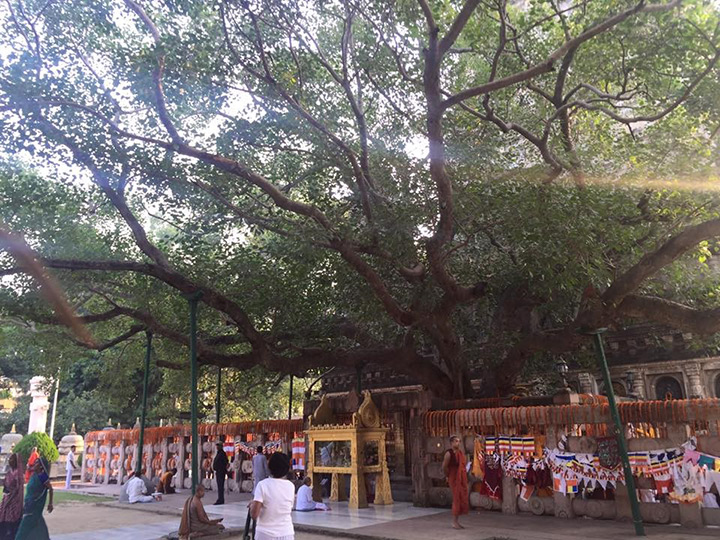
Works Cited:
- Buddhists Prepare To Observe Bodhi Day, When Siddhartha Gautama Became Buddha.” NPR.Org, https://www.npr.org/2020/12/05/943453999/buddhists-prepare-to-observe-bodhi-day-when-siddhartha-gautama-became-buddha. Accessed 15 Jan. 2021.
- Basics of Buddhism. https://www.pbs.org/edens/thailand/buddhism.htm. Accessed 15 Jan. 2021.
Lunar New Year marks the first new moon of the lunisolar calendar that is traditional to many East Asian nations. This year, Lunar New Year starts on Feb. 10, 2024 and the event is the most important holiday to many Asian countries, including Vietnam, South Korea, Singapore, and China. Ushering in the Year of the Rabbit, people will begin celebrations well in advance.
Within a household, it is traditional to cleanse the home prior to the new year. This is referred to as a “spring cleaning” in Chinese Traditions, and the Lunar New Year is called the “Spring Festival.” The ritual of sweeping removes harmful spirits lurking in the corners of one’s home. Windows are washed, parts of a house might be repainted, and renovations to the home are completed.
The day for sweeping marks the beginning of the major pre-holiday housecleaning projects, and on this day, according to tradition, the Kitchen God who has been watching over the household departs to the Jade Emperor in heaven to give his report of the household activities. If the individuals had been generous throughout the year, they will be rewarded in the next. But had they been unkind, the following year might bring hardship.
Lunar New Year is celebrated with one’s family, and individuals travel great distances to return home. Rituals include honoring family’s ancestors, and families eat foods with great symbolic meaning. One of these is a whole fish because in Chinese, fish is called yu. This is a homophone for the word meaning “surplus” or “abundance” in Chinese. Dumplings (jiaozi) are also eaten because the Chinese word for dumpling sounds like a term meaning “the meeting of the last hour of the old year with the first hour of the new.”
Children are given red envelopes (hongbao in Chinese) from their parents, and each envelope contains New Year’s money. Many individuals will furthermore wear clothes that are red because the color is said to bring good luck.
Celebrations continue until the 15th day of the first lunar month, known as the “Lantern Festival.” This day signals the end of the new year festival period, and it is another occasion for inviting guests to one’s home and holding feasts.
According to the Chinese zodiac, 2024 is the year of the dragon. It starts on February 10 and ends on January 28, 2025. Those born in the year of the dragon are said to be strong, successful, honourable, and fortunate.
For more information see:
- Asia For Educators. The Lunar New Year: Rituals and Legends. http://afe.easia.columbia.edu/special/china_general_lunar.htm
Steph Yin. “What Lunar New Year Reveals About the World’s Calendars.” New York Times. Feb. 5, 2019.
International Women’s Day’s history began on February 28, 1909. Known originally as “National Woman’s Day” it was first proposed by activist Theresa Malkiel and loosely based on the urban legend commemorating a protest by women garment workers in New York City, on March 8, 1857.
Inspired by Malkeil and other American activists, women’s rights activists Luise Zietz, Clara Zetkin and Kate Duncker suggested there should be an annual Women’s Day. One hundred women delegates at an international women’s rights conference from 17 countries agreed. On March 19, 1911, International Women’s Day was officially marked for the first time. More than one million people celebrated in Austria, Denmark, Germany and Switzerland. Women wanted not just the right to vote, but to fight against sex discrimination in the workplace and to hold public office.
In 1913, International Women’s Day was recognized in Russia for the first time, and became a part of a movement that led to the Russian Revolution in 1917. At that time, in St. Petersburg, women went on strike for “Bread and Peace” demanding the end to World War I, Czarism, and the shortage of food in Russia.
That day was March 8. The next day workers walked out of factories leading to mass strikes and the abdication of Nicholas II just seven days later, all resulting in Russian women earning the right to vote.
International Women’s Day began to spread to different countries and by 1949, it reached China where March 8th was declared an office “half-day of work” for women.
In 1967, the notion of women’s rights was taken up by the next generation of feminists, including those in the U.S. who called for equal pay, equal economic opportunity, equal legal rights, reproductive rights, subsidized child care and the prevention of violence against women.
The United Nations began celebrating International Women’s Day in 1975, which was declared “International Women’s Year”. In 1977, the United Nations invited members to proclaim March 8th as the UN Day for Women’s Rights and World Peace.
The 100 year celebration of International Women's Day occurred in 2011. In the United Kingdom activist Annie Lennox lead a march across one of London's iconic bridges raising awareness IWD and in support for global charity Women for Women International. By this time, IWD had become an official holiday in most countries around the world, including Afghanistan, Cambodia, Cuba, Guinea-Bissau, Kazakhstan, Laos, Madagascar, Mongolia, Nepal, Uganda, Ukraine, Uzbekistan, Vietnam and Zambia. In some countries IWD has the equivalent status of Mother's Day where children give small presents to their mothers and grandmothers. In others political rallies, business conferences, government activities and networking events are held as well as local women's craft markets, theatrical performances, fashion parades and the like. Many global corporations have come on board and actively supported IWD by running their own events and campaigns.
In the year 2024, with larger representations of women role models in every walk of life, one could think that women have gained true equality. While great improvements have been made in the last century, the unfortunate fact is that women are still not paid equally to that of their male counterparts, women are not present in equal numbers in business or politics, and globally women's education, health and the violence against them is worse than that of men. And so each year International Women’s Day not only inspires women to reach their dreams and celebrate their achievements, but also is a call to action for gender parity for all women throughout the world.
For more Information See:
Ramadan is the ninth month of the Islamic calendar, and is considered the Sacred (most important) month. It is remembered as the month that the Prophet Muhammed received the first revelations that comprise the Holy Quran. This religious annual observance and month of fasting is one of the Five Pillars of Islam.
During the month of Ramadan, adult Muslims fast from dusk until dawn, unless ill, pregnant, breastfeeding, diabetic, or traveling. The goal is for Muslims to grow spiritually and build stronger relationships with Allah, accomplished by:
- Praying and reciting of Quran
- Being intentional and selfless in actions
- Abstaining from gossiping, lying and fighting
- Fasting between sunrise and sunset
- Giving and performing generous acts
For 2024, Ramadan begins at sunset on Sunday, March 10, and will end at sunset on Tuesday, April 9.
- The Islamic calendar is a lunar calendar; therefore, the month of Ramadan migrates through the solar seasons, and it takes approximately 33 years to complete the backward migration through the Gregorian/western calendar.
- Traditionally, each day the fast is broken at sunset by drinking water and eating dates. Typically, the breaking of the fast ‘iftar’ is celebrated with family and friends, strengthening these relationships.
Eid Al-Fitr ‘Festival of Breaking the Fast’
- Eid Al-Fitr is a three-day festival after the last day of Ramadan. It is a coming together of community, friends, and family to eat special foods, enjoy each other's company, and exchange gifts.
- Eid is also celebrated to pay respect to Allah for providing the strength and endurance during the month-long fasting rituals.
- During Eid, fasting is not permitted.


Juneteenth
Celebrated on June 19, this holiday commemorates the end of slavery.
Although Juneteenth (also known as Freedom Day) was signed into law as a federal holiday by President Joe Biden in 2021, it has been celebrated for more than 150 years.
 History
History
President Abraham Lincoln issued his Emancipation Proclamation on January 1, 1863. The intent of the Proclamation was to free all slaves in the United States. Unfortunately, this news did not make it to the slaves of Texas until Union Major General Gordon Granger arrived in Galveston, Texas with his regiment on June 19, 1865. There he informed the people of Texas that the war was over and the slaves were free. The abolition of slavery was ratified into the U.S. Constitution with the 13th Amendment on December 6, 1865.
 Ways to Celebrate
Ways to Celebrate
Juneteenth can be celebrated in many ways and there are often local community events to participate in. These events can feature guest speakers who provide information to the community about Juneteenth and its history. Fishing, baseball, barbecuing, and fireworks are also typical Juneteenth activities. Education is frequently a focus. Juneteenth provides an opportunity to learn about and appreciate African American history and culture. Some choose to celebrate by shopping at black-owned businesses, sharing history, or taking the day to rest and recharge.
 Popular Foods include
Popular Foods include
- Red foods like strawberry soda pop, red punch, red velvet cake, red beans and rice, red fruits, and hot sauce
- Barbecue
- Corn, cornbread
- Collard greens
- Black-eyed peas
- Potatoes, yams, sweet potatoes
Visit your city’s website for information on Juneteenth events held near you.
 Sources/For More Information
Sources/For More Information
- Cherelus, G. (2020, June 18). This is how we Juneteenth. The New York Times.
- Jean-Philippe, M. (2021, May 21). The traditional foods of Juneteenth carry a rich history, dating back centuries. Oprah Daily.
- Juneteenth.com (n.d.). History of Juneteenth.
Bastille Day
Celebrated on July 14, Bastille Day, or la Fête Nationale, commemorates the storming of the Bastille, a Parisian military fortress and prison. The attack on the Bastille was a defining moment in the French Revolution.
History
The Bastille was built during the 1300s to protect the eastern entrance of the French city, Paris. The Bastille was used to hold prisoners, some of whom were locked up without a trial.
In the late 1780s, excessive spending by King Louis XVI and his wife, Marie Antoinette, pushed the French government closer to economic disaster. On top of the financial hardship of the government, France had experienced a nationwide famine and reduced customs duties caused increased unemployment.
To respond to the crisis, King Louis XVI called up the Estates-General, a national assembly grouped by social class (First Estate: clergy, Second Estate: nobility, and Third Estate: commoners). Although commoners made up nearly all the nation’s population, their group could be outvoted by the other two groups. In attempt to protect their rights, the Third Estate declared themselves a new body, committing to not disband until a new constitution was written.
King Louis XVI fired his finance minister and started moving army troops into Paris causing fear that force would be used to break up the group. In response, crowds of revolutionaries filled the streets of Paris, burning down customs ports and looking for food and weapons. The group eventually surrounded the Bastille. Delegates from the National Assembly were invited in to negotiate, but members outside became restless and swarmed the fortress.
Nearly 100 people died at the Bastille, sparking the country’s ten-year transformation into a republic.
Today
Today, Bastille Day is celebrated much like Americans celebrate the Fourth of July with fireworks, parades, and parties. French troops have solemnly marched every year since Bastille Day of 1880 as part of one of the world’s oldest military parades.
Sources/For More Information
- History.com Editors. “Bastille Day.” History.com, A&E Television Networks, 21 June 2017.
- Blakemore, Erin. “Bastille Day Celebrates the Rebellion That Ignited the French Revolution.” History, National Geographic, 26 Jan. 2022.
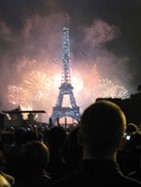
Picture Attribution: Eric Bréchemier from Paris, France, CC BY 2.0 , via Wikimedia Commons
Celebrated August 14-20.
Established as a tribal gathering in the early 1970’s, the festival in Davao has since transformed into a month-long cultural event. Focused around the third week of August, the festival marks the peaceful co-existence of nearly a dozen local tribes as celebrating the season’s bountiful harvest.
The festival’s name is derived from the Mandaya word madayaw, meaning treasured or valuable, in reference to the harvest season and the abundance of food it provided. Originally, the ethnic tribes of the area would come together to celebrate abundant crops, performing rituals that paid tribute to the nature gods as well as displaying the fruits of their labor and celebrating with music and dancing.
In the 1970s, then Mayor Elias B. Lopez, encouraged the different Davao tribes to showcase their thanksgiving rituals, turning the gathering to a true event. In 1986, the Davao City government launched a project that aimed to unite the people during the turbulent times of the Martial Law. In the beginning, the festival was called Apo Duwaling, after three natural wonders you can find in the region: Mt. Apo, Durian, and Waling-waling. It was first officially renamed as the Kadayawan Festival in 1988 by then Mayor Rodrigo Duterte.
While there are events celebrating Kadayawan all throughout the month of August, the main festival takes place during the third week of the month. The streets of Davao are festooned with bright colors and displays of fresh fruits are set up on almost every doorstep. There are a number of events which take place during the week of celebration but the three most popular are the Indak-Indak, Hudyakaan, and Pamulak.
Indak-Indak is a wild street dance which takes place throughout the city as each of the eleven tribes teams of dancers work their wat towards the Rizal Park, the main focal point of the festivities each year. A giant dance-off is held at the park which serves to officially kick off the festival.
Hudyakaan Hudyakaan is a food and beverage bazaar which is also set up in Rizal Park. Locals set up open street vending stalls selling hand crafted merchandise as well as local food and beverages. The Bazaar actually runs for three weeks and is seen by many as the center of the Kadayawan festival. It is an opportunity for different tribes to interact one another and spread their unique culture along with their most celebrated dishes.
While Indak-Indak officially opens the festival, Pamulak is viewed as the official closing ceremony. This is a city wide parade with floats decorated to show off the bountiful harvests as well as the cultures of each tribe at the festival. There are also floats celebrating other aspects of Davao, the Philippines, and events which took place during the festival itself. The dancers from the Indak-Indak also join in the parade along with beauty pageant winners and local celebrities.
Aside from the big events, there are also a slew of smaller activities which take place over the course of the festival, including weddings, beauty pageants, boat racing and various inter-tribal competitions. While the religious aspects of the festival have mostly fallen away, many people do take the time to set out small sacrifices to the gods of the harvest, usually in the form of fresh fruit or flowers set outside their homes.
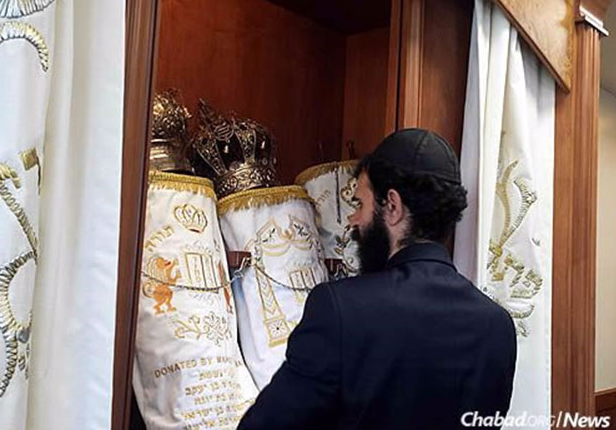
What: Together, Rosh Hashanah and Yom Kippur represent the "ten days of repentance" or "the days of awe". Rosh Hashanah is also a judgment day, when Jews believe that God balances a person's good deeds over the last year against their bad deeds, and decides what the next year will be like for them. My memory of worshiping in synagogue include rabbinical leaders stating “the gates are closing”,meaning a Jew’s fate is sealed for the year to come after the shofar is blown at the end of Yom Kippur services.
How Yom Kippur Is Observed
Like Shabbat, no work is to be done on Yom Kippur, from the time the sun sets on the ninth of Tishrei until the stars come out in the evening of the next day. On Yom Kippur, we afflict ourselves by avoiding the following five actions:
- Eating or drinking (in case of need, see here and consult a medical professional and a rabbi)
- Wearing leather shoes
- Applying lotions or creams
- Washing or bathing
- Engaging in conjugal relations
The day is spent in the synagogue, where we hold five prayer services:
- Maariv, with its solemn Kol Nidrei service, on the eve of Yom Kippur;
- Shacharit, the morning prayer, which includes a reading from Leviticus followed by the Yizkor memorial service;
- Musaf, which includes a detailed account of the Yom Kippur Temple service;
- Minchah, which includes the reading of the Book of Jonah; The story of Jonah and the Whale is more than a story of a disgruntled prophet, but represents both G-d’s justice and compassion.
- Neilah, the “closing of the gates” service at sunset, followed by the shofar blast marking the end of the fast.
'G'mar Chatima Tova!! (May you be Sealed in the Book of Life)
Day of the Dead: Ancestral Origin and Meaning
The return of the deceased is one of the oldest and most representative traditions among indigenous Mexican festivities. On Día de Muertos, the world of the living welcomes happily and lovingly the souls of the underworld through millenary traditions such as the ofrenda (traditional memorial displays), the sugar skulls, the pan de muerto (sweet bread of the dead), papel picado (pecked paper), candles, or the cempoalxóchitl flower (a marigold genus).
This festivity is one of the richest among the Mexican traditions. UNESCO inscribed Day of the Dead to its list of <Intangible Cultural Heritage of Humanity in 2008.

The Mexica used to celebrate their dead by honoring Mictecacihuatl and Mictlantecuhtli, the underworld couple, during the ninth month of their calendar (around August in the Julian calendar) and they would celebrate for an entire month dedicated to Mictlán’s ruling duality.
During the Mexica festivities of the departed, the main days were Miccailhuitontli—the Feast of The Lesser Dead, and the Huey Miccaihuitl, the Feast of The Greater Dead. These coincided with Europe’s Day of the Faithful Departed—then observed because of the deaths caused by epidemics—and All Saints’ Day—when they venerated all the saints without a specific holiday in the ecclesiastic calendar. At around the Day of the Dead and of the Faithful Deceased, the Irish Celtic Samhain Day—a pagan ritual that gave rise to Halloween—celebrated a banquet for the dead.
In ancient Mexico, the dead continued having an important role in society as they were honored depending on their rank and spiritual and social achievements. When someone died, the female elders in Tenochtitlan would announce plaintively the loss of that person. They could be memorialized by their families or by their calpulli (neighborhood), or by all the Mexica. For example, those hidden by Mictlantecuhtli, or who had gone to atlan oztoc, “the place of water in the cave” were called upon with rituals for sowing, hunting, or war. It also included birth and marriage as well as other magical rituals.
For the Mexica, skulls were important in their rituals. In the main temple, they would exhibit skulls of captives publicly impaled in the sacrificial altar to Tzompantli, to honor their deities and to show the power they had and extended beyond Tenochtitlán.
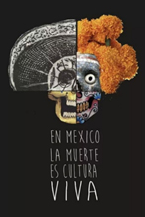
The precursor of the Pan de Muerto was the baking tradition in the Spanish kingdoms of León, Aragón and Castile to shape bread in the form of bones to imitate those that had allegedly belonged to saints (relics).
Each of the thirty-two Mexican states nowadays has its own distinctive touch for this celebration. For example, On October 28, some memorialize people who died in an accident; on October 30, some honor the babies who died before their Baptism. On October 31, they pay respect to children younger than 12, and November 1st is All Saints Day, when they honor the souls of those who died of natural causes. Finally, on November 2, after noon, this is when the souls of the departed return to their world. It is then that the ofrendas and the altars are cleared.
The communities prepare ahead of time and pay a lot of attention to the details because the ritual is extremely important, and as long as they do it properly, they believe that the dead are capable of bringing prosperity, for instance, an abundant corn harvest, or disgrace to their families. This encounter among the living and the dead consolidates the community’s social connections.
References:
- “Día De Muertos: Su Origen y Significado En 10 Datos Curiosos.” NeoMexicanismos, 1 Nov. 2020, https://neomexicanismos.com/cultura-mexico/dia-de-muertos-origen-en-mexico-porque-se-celebra-significado-tradiciones/. Portions accessed and translated from original in Spanish with permission on 10/24/2021
- García, Barbara. “Mictlan: Souls' Journey through the Underworld.” Mas México USA, Pepe Perez, 30 Oct. 2019, http://mas-mexico.com.mx/usa/index.php/2019/10/31/mictlan-souls-journey-through-the-underworld/.
- Herz, May. Inside Mexico, Babbel, 27 Sept. 2021, https://www.inside-mexico.com/category/myths-and-legends/.
- “Indigenous Festivity Dedicated to the Dead.” UNESCO, https://ich.unesco.org/en/RL/indigenous-festivity-dedicated-to-the-dead-00054.
- “Mexica.” Wikipedia, Wikimedia Foundation, 14 Oct. 2021, https://en.wikipedia.org/wiki/Mexica.
- Patowary, Kaushik. “Tzompantli: The Gruesome Skull Racks of the Aztecs.” Amusing Planet, Blogger, 25 Aug. 2021, https://www.amusingplanet.com/2021/08/tzompantli-gruesome-skull-racks-of.html.
- Vela, Enrique, “Días de Muertos”, Arqueología Mexicana, edición especial núm. 77, p. 80.
Indian "Festival of Lights
What: Diwali celebrates the triumph of light over dark and good over evil.
When: Diwali is celebrated during the Hindu month of Kartik, on the darkest day of the lunar month. Celebrated in India over a 5-day period, this year, the main (third) day of Diwali is Friday, November 1, 2024.
Where: Diwali is a national holiday in India, Singapore, and several other South Asian countries. However, it is celebrated around the world.
How: In India, celebrants light dozens of candles and clay lamps (called diyas), placing them throughout their homes and in the streets. Candles and lamps are also floated in lakes and rivers, and fireworks are lit to brighten the night sky.
Who: Diwali is primarily celebrated by followers of the Hindu, Sikh, and Jain faiths. Hindus celebrate the return of deities Rama and Sita to Ayodhya after their 14-year exile. They also celebrate the day Mother Goddess Durga destroyed a demon called Mahisha. For Hindus, it's also the start of the new year so there are special prayers offered to the goddess Lakshmi (goddess of wealth) for blessings and cash money in the new year Sikhs particularly celebrate the release from prison of the sixth guru Hargobind Singh in 1619. Jains celebrate the moment the founder of Jainism, Lord Mahavira, reached a state called Moksha (nirvana, or eternal bliss).
- Sources: Burnett, C. (2021). Diwali 2021: What is Diwali? The Old Farmer’s Almanac, https://www.almanac.com/content/diwali
- Diwali: What is it? (2020). BBC, https://www.bbc.co.uk/newsround/15451833
Kinro Kansha no Hi - Japanese Labor Thanksgiving
November 23
In Japan, November 23 is Kinro Kansha no Hi a national holiday which combines aspects of Labor Day and Thanksgiving in the United States. The day is set aside as a chance for people to honor common workers in society as well as spend time visiting green spaces and sharing a modest meal with family.
The holiday originally started out as Niinamesai, a fall harvest celebration, as far back as 660 BC, but by 686 AD it became associated with celebrating hard work throughout the year. Niinamesai had strong ties to Shinto religion, the ruling emperor held a grand event every year to celebrate and temples across Japan also took part.
After the end of World War II, the United States was uncomfortable with the Shinto aspects of the holiday and pressured Japan to alter or abolish the holiday. In response, the holiday was changed to Kinro Kansha no Hi, which translates to “gratitude to workers day”. This change kept the spirit of the holiday mostly intact while removing the imperialist and Shinto influences. Despite the official changes, the emperor still performs a quiet Niinamesai ceremony every year and temples continue to celebrate the holiday, though they usually refer to it by the modern name.
One of the biggest traditions during Kinro Kansha no Hi is for elementary school children to spend time creating hand made cards and gifts for people in the labor sector, such as police officers, fire fighters, and hospital staff. Workers will often visit the classrooms so the children can present their gifts and thank them in person for their service.
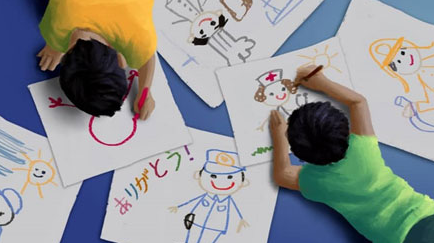 The holiday meal is not central to Japanese Thanksgiving as it is in the United States
and turkey is not usually on the menu. Instead, the traditional meal consists of fish,
rice, and tea, usually served in the evening after spending time taking part in outdoor
activities.
The holiday meal is not central to Japanese Thanksgiving as it is in the United States
and turkey is not usually on the menu. Instead, the traditional meal consists of fish,
rice, and tea, usually served in the evening after spending time taking part in outdoor
activities.
References:
- B, A. “Labor Day in Japan.” Labor Day in Japan | Japan Experience, 2016, https://www.japan-experience.com/plan-your-trip/to-know/understanding-japan/labor-day-in-japan.
- JRailPass, unknown. “Thanksgiving in Japan: Labour Thanksgiving Day.” JRailPass, 15 June 2022, https://www.jrailpass.com/blog/thanksgiving-japan.
- Kanpai, J. “Thanksgiving in Japan - Celebrating National Labor Day.” Kanpai Japan, 2018, https://www.kanpai-japan.com/travel-guide/thanksgiving-japan.
- Lu, Monique. “Don't Forget Your Thankful Feelings on Japan's ‘Labor Thanksgiving Day.’” FUN! JAPAN International, 15 Nov. 2021, https://www.fun-japan.jp/en/articles/11736.
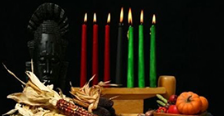 Kwanzaa is an original African American holiday started in 1966 by Dr. Maulana Karenga
and is not rooted in any particular religious philosophy. Its purpose is to unify
African Americans by instilling a sense of pride in their culture by annually joining
together to honor the traditions of their ancestors and plan for the year to come
by following a set of goals called Nguzo Saba, which means “seven principles” in the
nontribal African language Swahili.
Kwanzaa is an original African American holiday started in 1966 by Dr. Maulana Karenga
and is not rooted in any particular religious philosophy. Its purpose is to unify
African Americans by instilling a sense of pride in their culture by annually joining
together to honor the traditions of their ancestors and plan for the year to come
by following a set of goals called Nguzo Saba, which means “seven principles” in the
nontribal African language Swahili.
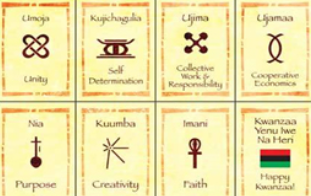 The seven principles are discussed and acted upon during each of the seven days of
Kwanzaa, which starts every year on December 26 and ends on January 1. A table is
set with fruit & vegetables, including one ear of corn for each child in the family,
and are all placed on a straw mat call the mkeka. Red, green and black candles are
also placed in a kinara candle holder and one candle is lit for each day of Kwanzaa,
representing one of each of the seven principles.
The seven principles are discussed and acted upon during each of the seven days of
Kwanzaa, which starts every year on December 26 and ends on January 1. A table is
set with fruit & vegetables, including one ear of corn for each child in the family,
and are all placed on a straw mat call the mkeka. Red, green and black candles are
also placed in a kinara candle holder and one candle is lit for each day of Kwanzaa,
representing one of each of the seven principles.
Day 1 Umoja (Unity): Working together in peace.
Day 2 Kujichagulia (Self-determination): Accomplish the goals we have set for ourselves.
Day 3 Ujima (Collective work and Responsibility): Solve problems together to make our community a safe and productive place.
Day 4 Ujamaa (Cooperative Economics): Build and maintain our own businesses and profit from them together.
Day 5 Nia (Purpose): To have a plan for the future and to be willing to help others to succeed.
Day 6 Kuumba (Creativity): To always do as much as we can to leave our community a better and more beautiful place.
Day 7 Imani (Faith): To believe with all our heart in our people, our parents, our teachers, our leaders, and the righteousness and victory of our struggle.
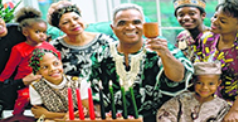 On the sixth day of the Kwanzaa a feast is held for family and friends called Karamu.
Handmade or purchased gifts are often given, to open on the 7th day, to improve the
mind and heart of the person who receives them. Stories, songs, dances, drumming,
and skits occur throughout the Karamu celebration. The principles, symbols and traditions
that are a part of Kwanzaa celebrate the beauty of African Americans working together
for the good of the community and is encapsulated by the Swahili word ‘Harambee’ used
throughout Kwanzaa, which means “Let’s all pull together!”
On the sixth day of the Kwanzaa a feast is held for family and friends called Karamu.
Handmade or purchased gifts are often given, to open on the 7th day, to improve the
mind and heart of the person who receives them. Stories, songs, dances, drumming,
and skits occur throughout the Karamu celebration. The principles, symbols and traditions
that are a part of Kwanzaa celebrate the beauty of African Americans working together
for the good of the community and is encapsulated by the Swahili word ‘Harambee’ used
throughout Kwanzaa, which means “Let’s all pull together!”
